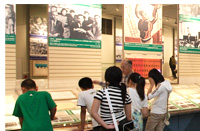| |


|
|
 |
 |
After World War I, there was a period when the devastation caused by the war
made people pause to reflect, and the time seemed ripe for international cooperation
and arms reductions.The first display case in this section of the museum shows
information about the League of Nations and the promise for peace it offered
at that time.This trend was quickly reversed in Japan, however, with the start
of the Fifteen-Year War.The anti-war movement was suppressed, and freedom of
thought and academic pursuits in the country were curtailed.The second display
case in this section illustrates examples of such repressive measures.The Peace
Preservation Law passed in 1925 played a central role in limiting the freedom
of Japanese citizens to criticize imperial rule or to expound Communist or anti-war
ideologies.As the military strengthened its control on the nation, not only
communism, but also liberalism and all other movements opposed to fascism were
suppressed. Then in 1933, the Minister of Education began reining in academic
freedom, criticizing a textbook written by Kyoto University Professor Yukitoshi
Takigawa and forcing Takigawa to resign despite widespread protests by other
professors.One of the declarations signed by Takigawa's supporters is exhibited
in the fourth display case. Then in 1933, the Minister of Education began reining in academic
freedom, criticizing a textbook written by Kyoto University Professor Yukitoshi
Takigawa and forcing Takigawa to resign despite widespread protests by other
professors.One of the declarations signed by Takigawa's supporters is exhibited
in the fourth display case.
|
 |
Even though the Japanese government clamped down on anti-war activities, a small number of liberals and members of religious groups opposed facism and the war.There were also people who, while not joining the anti-war movement,
refused to cooperate with the war effort.Others simply became weary of the war, and as it drew to a close, were increasingly critical of the Japanese government.In addition, many Japanese who fled Japan for exile in China and the
U.S.denounced the war.The last display cases in this section highlight these movements.
|
| |

|
The leaflet, designed to make Japanese soldiers feel tired of war, was distributed to troops in China. The sleeping woman thinks, “How sad to be able to meet only in dreams every night. When will we see each other again?” (On loan from Chikako Seguchi)
|
|
|
| |
|
|
|
 |
|
|
|